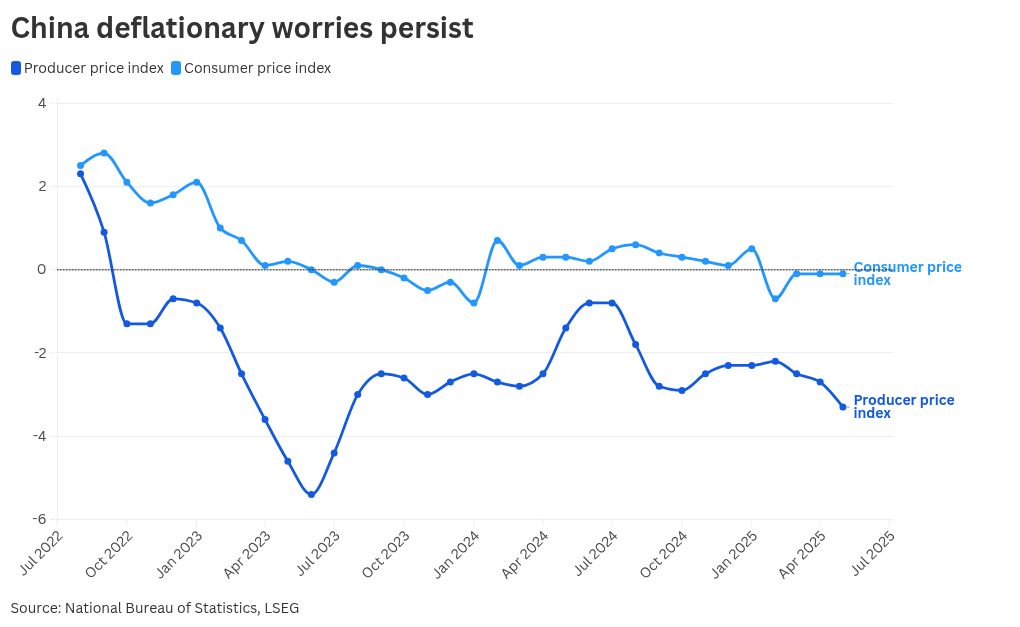China’s consumer prices fell for a fourth consecutive month in May, as Beijing’s stimulus measures appear insufficient to boost domestic consumption, with price wars in the auto sector adding to downward pressure.
The consumer price index fell 0.1% from a year earlier, according to data from the National Bureau of Statistics released Monday, compared with Reuters’ median estimate of a 0.2% decline.
CPI slipped into negative territory in February, falling 0.7% from a year ago, and has continued to post year-on-year declines of 0.1% in March, April, and now May.
Core inflation, excluding food and energy prices, however, rose 0.6% in May — highest since January this year, according to Wind Information.
Separately, deflation in the country’s factory-gate or producer prices deepened, falling 3.3% from a year earlier in May, marking the steepest decline since July 2023 and a sharper drop compared with analysts’ estimates of a 3.2% fall, according to LSEG data.
Wholesale prices have remained in deflationary territory since October 2022.
Aside from the persistently weak consumer demand, a bruising price war in the automotive industry has kept prices lower, said Zhiwei Zhang, president and chief economist at Pinpoint asset management.
Chinese policymakers have urged the automotive industry to halt the brutal price wars, which had hurt businesses’ profitability and efficiency, driving prices lower.
“The price war in the auto sector is another signal of fierce competition driving prices lower,” Zhang said, adding that falling property prices also contributed to the downward pressure in consumer prices.
While exports have been holding strong, “eventually China needs to rely on domestic demand to fight the deflation,” Zhang added.
Factory-gate prices for coal mining, and oil and gas extraction firms saw the biggest drop in prices, plunging 18.2% and 17.3%, respectively, from a year ago, the official data showed.
NBS Chief Statistician Lijuan Dong emphasized on the need for “more forceful and targeted stimulus measures to boost consumption.”
On May 7, Chinese top financial regulators unleashed a flurry of policy steps aimed at bolstering the country’s tariff-hit economy. China’s central bank cut the key interest rates by 10 basis points to historic-low levels and lowered the reserve requirement ratio, which determines the amount of cash banks must hold in reserves, by 50 basis points.
U.S. President Donald Trump had ratcheted up tariffs on Chinese goods to prohibitive levels of 145%, prompting Beijing to retaliate with duties and other restrictive measures, such as export controls on its critical minerals.
On May 12, the economy got a relief after U.S. and China struck a preliminary deal in Geneva, Switzerland that led both sides to drop a majority of tariffs. Washington lowered its levies on Chinese goods to 51.1% while Beijing dropped taxes on American imports to 32.6%, according to think tank Peterson Institute for International Economics, allowing some room for both sides to negotiate a broader deal.
Chinese Vice Premier and lead trade representative He Lifeng is expected to meet with the U.S. trade negotiation team led by Treasury Secretary Scott Bessent in London later in the day for renewed trade talks.
The second-round of meetings come after tensions flared up again between the two sides, as they accused each other of violating the Geneva agreement.
Washington had blamed Beijing for slow-walking its pledge to approve the export of additional critical minerals to the U.S., while China criticized the U.S. decision to impose new restrictions on Chinese student visas and additional export restrictions on chips.
China’s Ministry of Commerce said on Saturday that it would continue to review and approve applications for export of rare earths, citing growing demand for the minerals in robotics and new energy vehicle sectors.
As the temporary trade truce with the U.S. appeared shaky, markets are watching whether Beijing will roll out more monetary easing to boost the economy.
In an article published last week, state-run media China Securities Journal said the PBOC may bring down the RRR further later this year to support growth, and could soon end a months-long pause on government bond trading. The central bank had paused bond purchases in January in an attempt to curb the plunging bond yields and a weakening currency.
Eyes will be on the annual Lujiazui forum to be held later this month in Shanghai, where China’s top financial regulators, including the PBOC governor Pan Gongsheng, will deliver keynote speeches. Shanghai government officials told reporters last month that major financial policies will be revealed at the forum.
China is also due to report its trade data for May later on Monday, which is expected to show exports rose 5% year on year while imports fell 0.9% from a year earlier, according to a Reuters poll.
— CNBC’s Evelyn Cheng contributed to this story.



